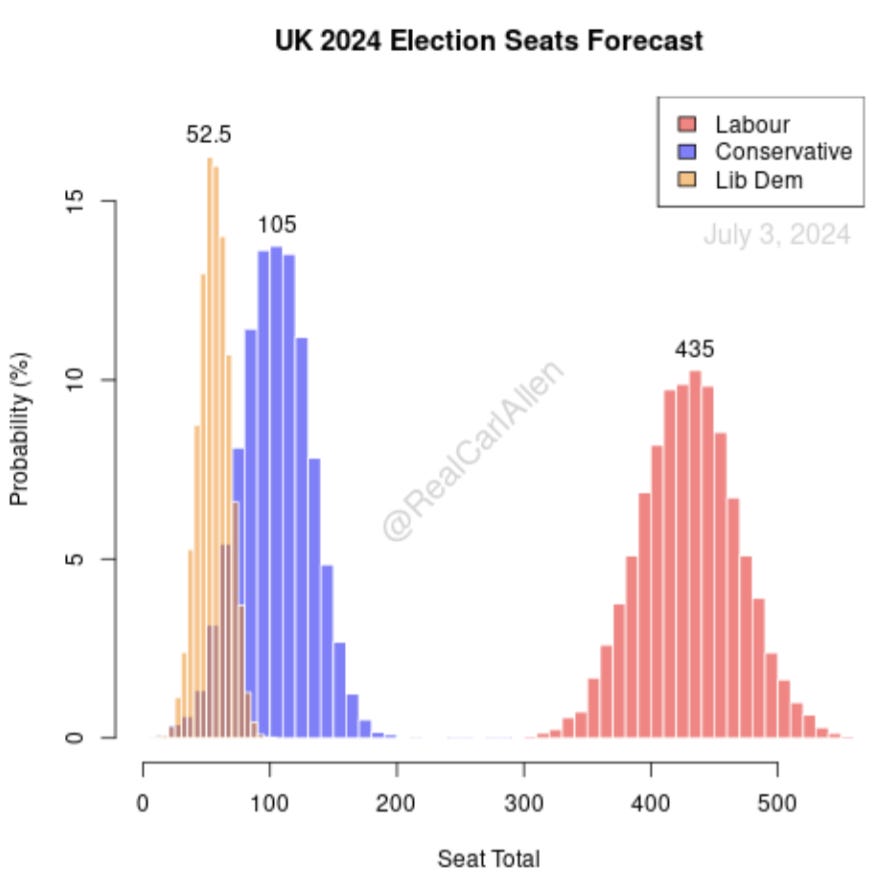Pollsters in the UK are deceitful, by tradition. In closely contested elections, those lies come back to haunt them.
A 5 point forecast error like 2017, or Brexit, which were considered close - were so devastating they convened alleged experts to figure out what happened. They failed to do so. A much larger error in 2024’s Mayoral elections, in which Labour were large favorites, no one cared, because the 10 point forecast error of the pollcasters didn't impact the result.
This predictable, huge error is less likely in the general election, though a medium-sized error (like 2017) is definitely possible.
Conservatives and Reform will likely fracture the right wing vote, so substantially that Labour could take a huge majority with just 40% of the national vote.
But since it's unlikely the majority will tilt on even a 5 point error, so such a disconnect would go without concern this year.
All that said, here's my forecast.
First, the popular vote
I'm somewhat more bullish on both Labour and Conservatives than pollcasters who have them hovering around 40. While I'm a little concerned talks of a Labour blowout could suppress turnout, their floor in my opinion is still around 38. That makes them getting into the 40s highly likely, in my opinion, as you can see.
My previous forecast priced in some Reform defection to Conservative, which I still think will be the case (Reform closer to 13, Conservative closer to 24 wouldn't surprise me) but the median is the median.
And the seat total
These three parties figure to hold the most. Lib Dems don't pull from Labour as much as Reform will from Cons, thanks to more strategic voting in their constituencies. The same can be said for Green, and other parties, who will likely hold a few seats each. An outright majority seems nearly certain for Labour, with only about a 1% chance they don't reach the 326 threshold.
A better way to view the data, in my opinion, are probability bins.
Flip a coin, and I think there's an equal chance (50%) we end up with Labour between 404 and 456 seats as they do higher or lower.
Roll a single die and pick any 5 of the 6 numbers. I think there's the same chance you have chosen the right number (5/6, or about 83%) as Labour ends between 381 and 484.
Here are the same bins for Con and LD:
Conservative 50% range: 85-123 seats
Conservative 83% range: 66-144 seats
Lib Dem 50% range: 47-65 seats
Lib Dem 83% range: 39-71 seats
Survation, a reputable polling company who is by all means better qualified than me, published this:
In keeping with the statistically illiterate tradition of making “calls” as a pollster, they've applied a pseudoscientific “credible interval” to indefensibly precise outcomes. Good luck.
Update: July 5th. The result is outside their “95% credible intervals” for all 3 parties above.
While anything but a comfortable Labour majority would be surprising, do not let anyone convince you they “know.” They don't. In the case of UK pollsters, they don't even know the difference between polls and forecasts.
If nothing else, moving to the UK looks like a reasonable option if things don't go well in the US.
My first US forecast will come soon.
A small (July 3rd) update re: Survation’s “95% intervals”
I didn't include parties past Lib Dems in my forecast because they messed up the y-axis (because the range of outcomes are so narrow)
But Survation's Reform number really caught my eye.
Notice, their 95% interval has a mean of 15, with a low end of 5. Meaning a 2.5% chance they get under 5 seats.
I am not an expert on the UK, or their elections. But I cannot find 15 seats for Reform.
Maybe I'm wrong, and I'll learn from these experts.
Or maybe Reform will end with 2-3 seats, and I'll have to be obnoxious again.
Update: July 6th Reform has 5 seats. I'll probably still be obnoxious. (Survation was outside their 95% confidence for the top 3 parties)








